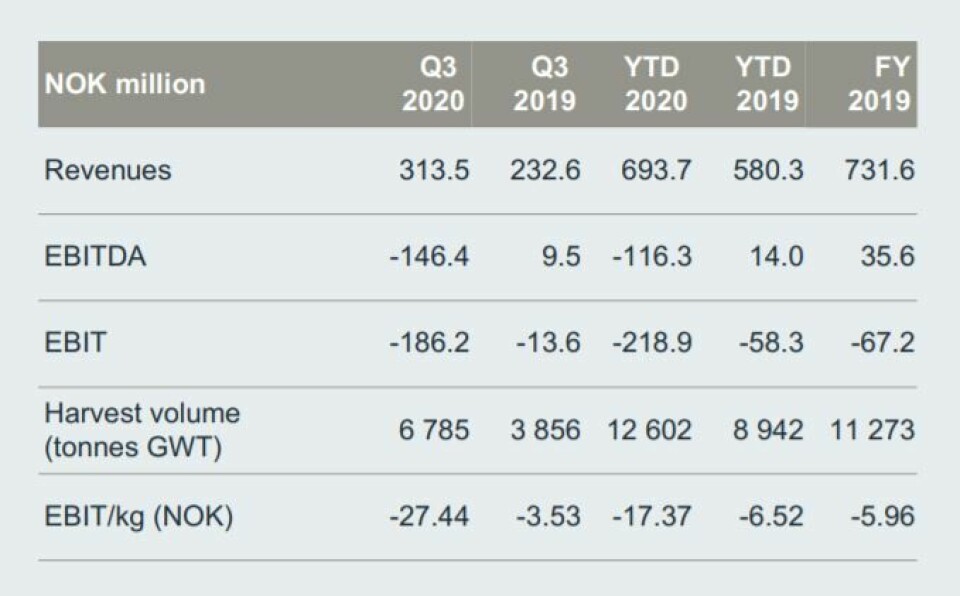
Grieg seeks to sell struggling Shetland operation
Grieg Seafood has announced plans to sell its salmon farming operations in Shetland.
The company has struggled to make money from its Scottish farms, and recently announced the closure of its operations on Skye following high fish mortality caused by jellyfish.
Today it followed that decision with an announcement that it intends to sell the rest of its Scottish operation, based in Shetland.
Strategic alternatives
“Medium to long-term, our focus will be in the areas with the best potential for sustainable growth during the post Covid-19 recovery period, which is our Norwegian and Canadian regions,” said chief executive Andreas Kvame in the introduction to Grieg’s third-quarter report.
“As such, we have initiated an evaluation of strategic alternatives for our Shetland region. We aim for a sale when the timing is right.”
Lower costs
The Grieg boss continued: “Through organic initiatives, we target 100,000 tonnes harvest (excluding Shetland) in 2022 with an average farming cost for the Norwegian operations below NOK 40/kg and CAD 7/kg in BC.
“For 2025, we target 130,000 tonnes of harvest and continued reduced cost per kg. A potential sale of Shetland will significantly lower our overall production costs per unit.”
Grieg announced in September that it was ending the operation at its five farms on Skye. It said Skye was too far from Shetland to operate the two areas as one unit, and the Skye operation was too small to be operated as a separate unit.
Jellyfish
The decision was expedited by high mortality at three of the Skye farms between late July and early-September, mainly caused by abnormal levels of jellyfish, when 627,000 of fish (approximately 1,500 tonnes) died. The three farms were closed down immediately, and the two remaining farms will close after harvest in 2021.
Grieg has 16 salmon farming sites in Shetland listed on the Scottish government’s Scotland’s Aquaculture website as being active within the last three years, although it has been ceasing operations at some of its most difficult-to-farm sites during that period.
That policy, along with the Shetland operation’s focus on producing healthier, more robust smolts, has seen production volume increase to an expected 15,000 tonnes this year. But the problems on Skye have exacerbated production costs that have historically been higher than those in Grieg’s two Norwegian regions, Rogaland and Finnmark.

£2.29 per kilo loss
In Q3 this year Grieg Seafood Shetland made an operating loss of NOK 186.2 million (£15.6m), which works out as a loss of NOK 27.44 (£2.29) per kilo on a harvest of 6,785 gutted weight tonnes.
The Shetland results and weak spot prices pushed Norway-based Grieg Seafood into a loss before fair value adjustment of NOK 192m for Q3, compared to a positive EBIT of NOK 143m in the same period last year. That equates to a loss per kilo of NOK 9.0, compared to positive earnings of NOK 6.8 in Q3 2019.
Grieg saw good performance in Norway, which earned total EBIT/kg NOK 9.9 (11.2), but the operation in British Columbia, Canada made a loss of NOK 51.6m on a harvest of 6,648 gwt (Q3, 2019: 4,168 gwt). EBIT per kilo was NOK -7.76. Grieg BC experienced harmful algal blooms and high sea lice pressure in the quarter, and the rolling 12-month survival rate decreased from 90% at the end of Q2 to 86% at the end of Q3.
Challenging quarter
Kvame, said: “The third quarter was challenging for Grieg Seafood. Effects of the Covid-19 impacted price achievements negatively in all markets and we experienced operational challenges out of the ordinary on Isle of Skye.
“On the other hand, our Norwegian regions delivered good results in the quarter. Progress is made at our recently acquired greenfield project in Newfoundland, and healthy fish are growing in our new hatchery. However, to lower risk in the initial phase of the project, we have decided to defer the construction of the first post-smolt unit to 2023, without causing delay to our target of harvesting 15,000 tonnes in 2025.”























































